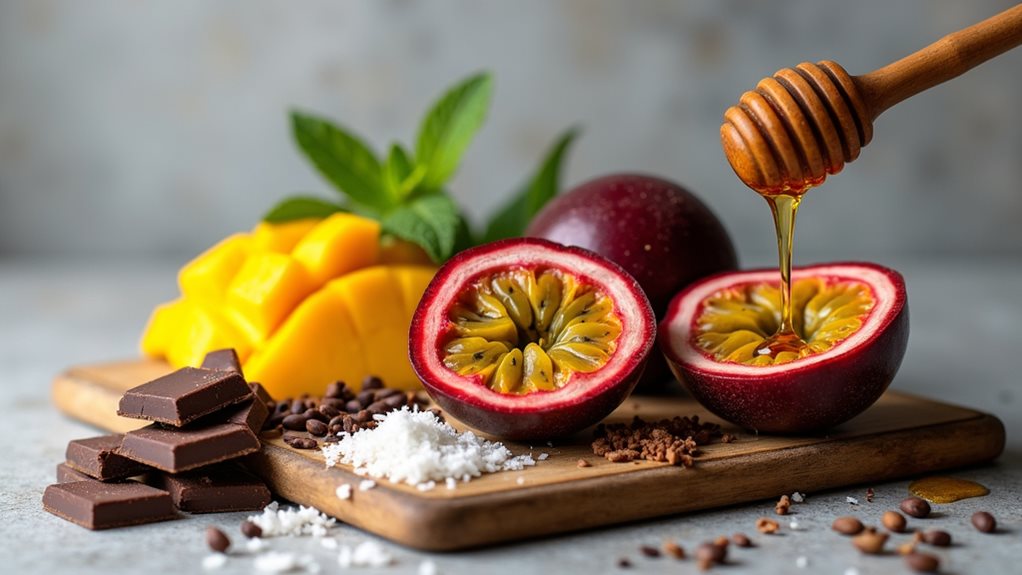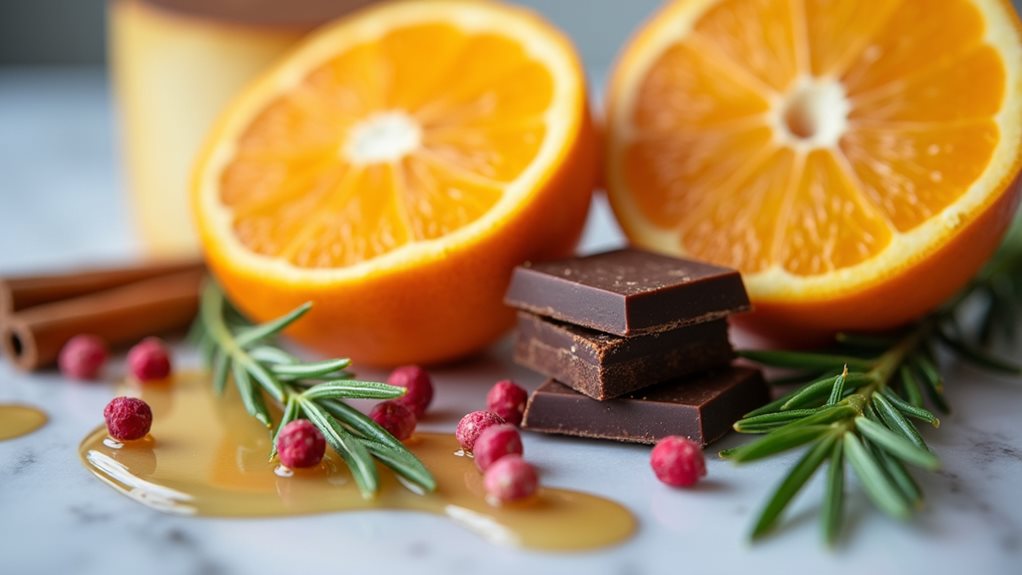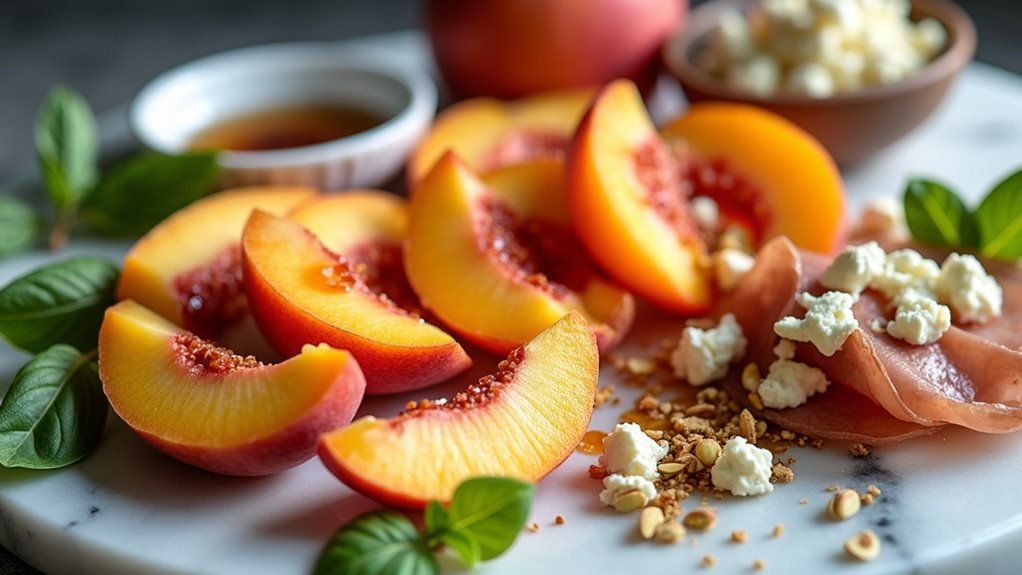Passion fruit pairs exceptionally well with tropical fruits like mango, pineapple, and coconut, which balance its tartness with natural sweetness. You'll find that citrus elements (lime, orange) enhance its acidity while vanilla creates a classic sweet counterbalance. For beverages, try mixing with rum, gin, or vodka, and don't forget complementary mixers like ginger beer or coconut water. Fresh herbs such as mint or basil can elevate your creations, especially when combined with visually striking garnishes. The possibilities extend far beyond these fundamental combinations.
Classic Fruit Companions That Enhance Passion Fruit's Profile

While passion fruit's distinctive sweet-tart flavor can stand on its own, pairing it with complementary fruits can create extraordinary flavor combinations that highlight its tropical essence.
Mango and pineapple offer perfect partnerships, bringing their natural sweetness to balance passion fruit's tartness in a vibrant fruit salad or invigorating tropical smoothies.
Citrus fruits elevate passion fruit's natural acidity—try adding lime for zestiness or orange zest for subtle sweetness.
For a more exotic twist, combine passion fruit with guava, kiwi, or papaya. Berry pairings, especially blueberry and raspberry, create exciting contrasts that enhance passion fruit's complexity.
Banana provides creamy texture in tropical smoothies, while coconut cream introduces rich, velvety notes to desserts.
White chocolate creates a luxurious counterpoint to passion fruit's tartness, offering a mononote flavor that allows the fruit's complexity to shine through.
These pairings don't just complement passion fruit—they transform it, creating multi-dimensional flavor experiences you'll want to explore repeatedly.
Spirits and Mixers That Elevate Passion Fruit Cocktails
Passion fruit's vibrant, tropical essence transforms into something truly remarkable when paired with the right spirits and mixers. Rum naturally complements its fruity tartness in tropical concoctions, while gin offers a crisp counterbalance to its sweetness.
Discover passion fruit's exotic allure—where rum embraces its tartness and gin provides the perfect crisp counterpoint.
Don't overlook vodka's neutral profile, which lets passion fruit's unique character shine through in modern cocktail trends.
For mixers, fresh lime juice enhances the fruit's natural citrus notes, while muddled mint creates invigorating complexity. The Master of Mixes version features premium Persian lime juice blended with Vietnamese passionfruit for authentic flavor. Experiments with homemade recipes show that mint leaves add an aromatic dimension to passion fruit drinks, as demonstrated in the Passion Fruit & Mint Cooler.
Try incorporating passion fruit through various techniques—purees work beautifully in layered drinks, while syrups provide consistent sweetness.
For your next flavor experiments, consider a passion fruit margarita with tequila or an innovative passion fruit mule. These combinations showcase why this exotic fruit continues to captivate mixologists worldwide.
Presentation Techniques and Garnishes for Visual Impact
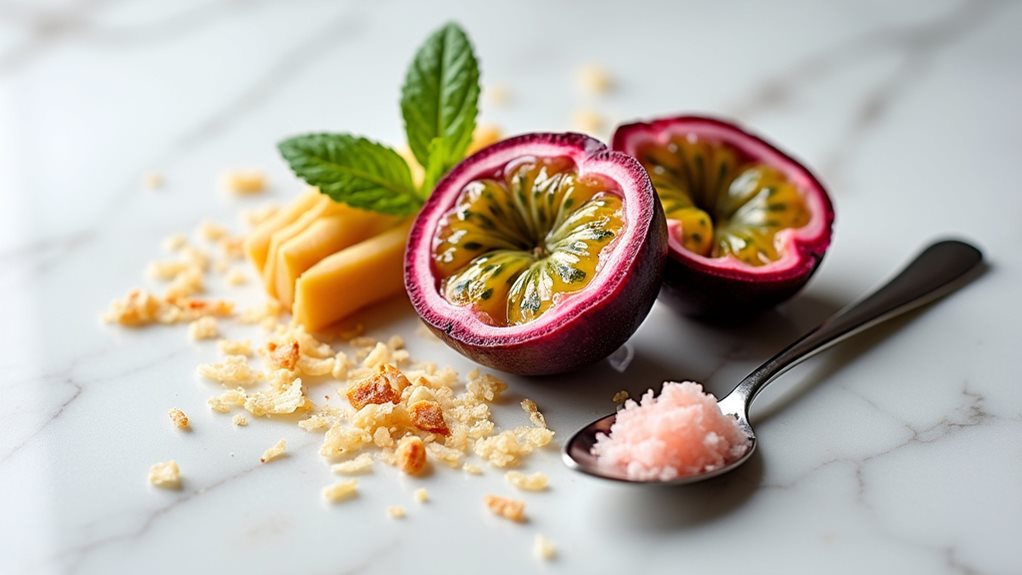
Your passion fruit cocktails will stand out with eye-catching rim decorations like colored sugar, crushed freeze-dried fruits, or even edible gold that complement the drink's vibrant hues.
Consider adding delicate edible flowers such as pansies, violets, or nasturtiums arranged thoughtfully around the glass rim or floating atop your creation to create a sophisticated, botanical appeal.
You can also impress your guests with color-changing garnishes by incorporating butterfly pea flower tea ice cubes that transform from blue to purple when they interact with the acidic passion fruit, creating a dramatic visual element that enhances the drinking experience.
Clear glass vessels are ideal for passion fruit creations as they showcase the vibrant layers and colors, making your presentation even more impactful.
For data-driven insights on effective presentation techniques, consider exploring the model outputs from alpaca_eval, which contain valuable evaluation metrics for various creative applications.
Dramatic Rim Decorations
The visual impact of a passion fruit cocktail begins well before the first sip, with the rim decoration serving as the dramatic introduction to your drink's flavor journey.
Like dramatic lighting in photography, a well-executed rim creates a halo effect that draws your guest's attention to the glass. The technique mimics how rim lighting setup enhances the outline of subjects, creating distinct boundaries that captivate the viewer. Consider using barn doors or grids to precisely control where decorative elements are placed on the rim, preventing unwanted spillover into the drink itself. Consider using colored sugars that complement the golden hues of passion fruit, creating visual storytelling through contrast.
Position your garnishes strategically behind the glass to create a silhouette effect, separating your cocktail from its background. Incorporate smoke elements by using dehydrated citrus dust or toasted coconut for texture.
For maximum impact, layer different textures around the rim—perhaps crystallized ginger alongside black salt—creating a multi-dimensional experience that highlights the complex flavors within.
These techniques don't just decorate; they amplify the sensory adventure that awaits.
Edible Flower Arrangements
When elegant cocktails demand more than just flavor, edible flower arrangements transform passion fruit libations into visual masterpieces that captivate before the first sip.
You'll create stunning presentations by incorporating edible flower varieties like nasturtiums, pansies, and violets, which complement passion fruit's tropical notes while adding delicate contrasting flavors.
For maximum impact, layer your floral arrangement techniques: freeze calendula petals in ice cubes, float rose petals on the surface, or create height with basil foliage and zucchini blossoms along the glass rim.
Verify all flowers are safe for consumption before using them.
When pairing, consider both visual harmony and flavor profiles—lavender's aromatic notes enhance passion fruit's sweetness, while bright nasturtiums add a peppery contrast that awakens the palate. Using crumpled chicken wire inside your vase creates a sturdy foundation that helps position each edible flower precisely where you want it. Health-conscious hosts should select organic flowers grown away from chemicals to ensure safety for consumption.
These thoughtful combinations elevate your drink from refreshment to conversation piece.
Color-Changing Garnish Techniques
Color-changing garnishes transform passion fruit cocktails and dishes from static presentations into dynamic culinary performances that evolve before your eyes.
You'll captivate guests when you incorporate pH-sensitive edible dyes that react to passion fruit's natural acidity, shifting from blue to vibrant pink when mixed.
Try dusting the rim of passion fruit cocktails with thermochromic powders that change color with temperature variations—cool purple when chilled, warming to magenta as guests hold the glass.
For plated desserts, create butterfly pea flower ice cubes that gradually release their color-changing properties as they melt into passion fruit coulis.
These techniques aren't merely decorative; they heighten anticipation and engagement with your culinary creation, turning a simple garnish into an interactive experience that celebrates passion fruit's complex flavor profile.
Sweet Applications: Desserts and Confections
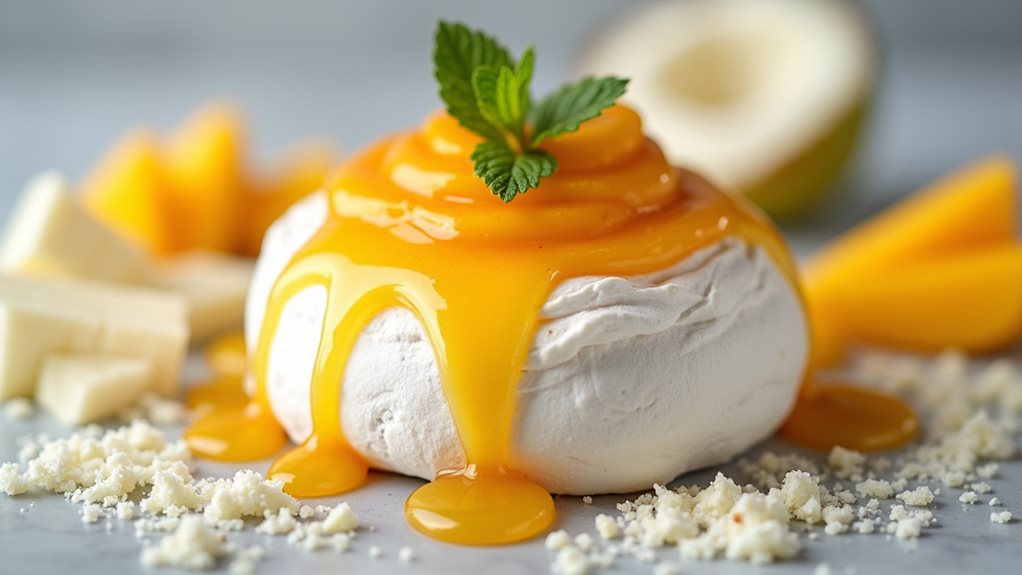
Passion fruit's vibrant sweet-tart profile transforms ordinary desserts into extraordinary tropical indulgences that'll tantalize your taste buds.
You'll discover endless dessert variations by incorporating passion fruit into mousses, pudding cakes, and shortbread bars, each offering unique flavor contrasts that balance sweetness with acidity.
Try pairing passion fruit with vanilla for a classic combination, or add a touch of citrus to enhance its natural tanginess.
Create creamy confections by stabilizing passion fruit mousse with gelatin or preparing a rich curd for tart fillings.
For more complex textures, combine passion fruit with other tropical fruits like mango or coconut in cheesecakes, layer cakes, or fruit salads.
The seeds add a delightful crunch to smooth desserts, while the puree works beautifully in frozen treats and pastry fillings for eclairs or croissants.
For an elegant presentation inspired by historical French desserts, serve passion fruit mousse in individual ramekins similar to chocolate pots for a sophisticated dinner party finale.
Non-Alcoholic Beverage Combinations Worth Trying
Beyond the dessert table, passion fruit's vibrant flavor profile elevates revitalizing beverages that don't require a splash of alcohol to impress.
You'll discover remarkable mocktail recipes by pairing passion fruit with ginger beer for a spicy-sweet kick, or coconut water for a hydrating tropical blend.
For perfect flavor balance, combine passion fruit with lime or orange juice, then enhance with aromatic herbs like mint or basil.
Fruity infusions work wonderfully—try mixing with pineapple juice for an intensified tropical experience, or apple juice for subtle sweetness.
Consider kombucha as your base for a gut-friendly option with natural effervescence.
Don't overlook herbal notes from lemongrass or the complexity that citrus zest can bring to your revitalizing combinations.
Garnish with passion fruit seeds or edible flowers for a visually stunning presentation.
Much like the gentle tossing technique used in watermelon feta salads, take care when mixing passion fruit beverages to preserve the delicate texture of the fruit while ensuring flavors blend harmoniously.
Preservation Methods and Product Development Insights
While passion fruit's exotic flavor dazzles the palate, its relatively short shelf life presents considerable challenges for both consumers and producers.
The tropical paradox of passion fruit—sensory brilliance constrained by fleeting freshness.
You'll find advanced preservation techniques can dramatically extend freshness—storing yellow varieties at 7-10°C and purple varieties at 3-5°C can achieve shelf lives of two and five weeks respectively.
For maximum longevity, maintain 90-95% humidity and implement modified atmosphere packaging, which considerably reduces moisture loss.
Innovative product development leverages chitosan-based coatings that form protective barriers against spoilage. These coatings, applied through spraying or brushing, effectively control bacterial growth while maintaining the fruit's natural qualities.
Don't overlook the commercial potential—preserved passion fruit products like jams and jellies offer versatile applications in desserts and baked goods, creating new market opportunities through extended distribution capabilities.
Frequently Asked Questions
Does Passion Fruit's Flavor Change When Cooked Versus Raw?
Yes, you'll notice raw versus cooked passion fruit differs considerably. When heated, it loses its intense tropical aroma and bright acidity, developing richer caramel notes while sacrificing some of its natural flavor intensity.
Can Passion Fruit Seeds Be Used in Cooking or Should They Be Removed?
You can definitely use passion fruit seeds in cooking for their crunchy seed texture. They're great in smoothies, salads, and desserts. For smoother dishes like sauces, you'll want to remove them. Explore both culinary uses!
How Can I Balance Passion Fruit's Acidity in Savory Dishes?
Like taming a wild tiger, you'll master balancing acidity by pairing passion fruit with dairy (crème fraîche), adding honey for sweetness, incorporating herbs like cilantro, and exploring savory pairings with grilled meats or seafood.
Are There Any Herbs That Particularly Complement Passion Fruit Flavors?
Try mint garnish for a revitalizing contrast to passion fruit's tanginess. You'll love how basil infusion adds unexpected dimension. Lemongrass also works beautifully, bringing citrusy notes that elevate your innovative culinary creations.
What Cheeses Pair Well With Passion Fruit in Appetizers or Cheese Plates?
You'll find goat cheese's creamy texture beautifully balances passion fruit's tang. Don't overlook blue cheese for a bold contrast. Try mascarpone for luxurious sweetness or feta for a bright, Mediterranean-inspired appetizer combination.
Final Thoughts
You've now released passion fruit's full potential through thoughtful pairing strategies. Beyond the classic tropical combinations, you'll find exciting flavor partnerships with herbs, spirits, and unexpected ingredients that telegraph your culinary sophistication to guests. Remember, passion fruit's versatility extends from breakfast smoothies to elegant desserts and complex cocktails. Trust your palate, experiment confidently, and you'll discover unique combinations that highlight this exotic fruit's distinctive sweet-tart profile.

